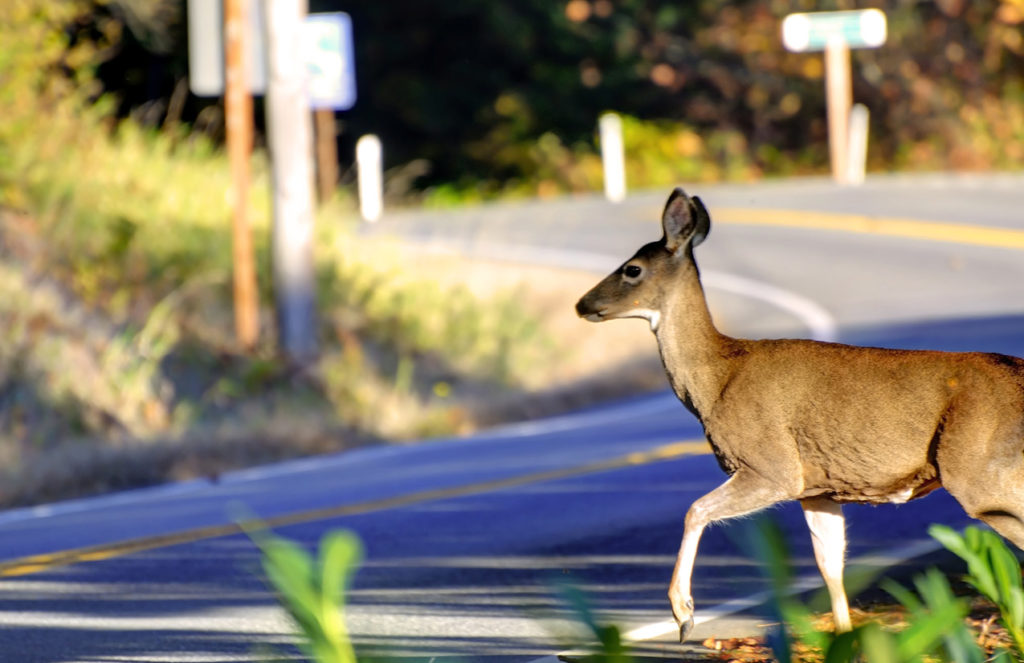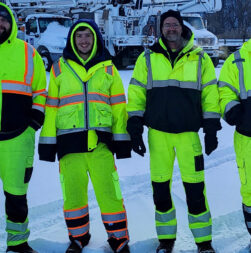Wildlife is all around us. The Chesapeake Bay Program lists over 30 wild mammals common in our region, including skunks, opossums, squirrels, foxes, deer, beavers, muskrats, raccoons, minks, fishers, porcupines, bears, bobcats, and yes, even groundhogs (also known as woodchucks.)

If you’re on the road a lot, you will eventually encounter a wild animal in your path. According to State Farm, “U.S. drivers on average have a 1 in 116 chance of a collision with an animal. There were over 1.9 million animal collision insurance claims in the U.S. between July 1, 2019, and June 30, 2020.”
When a vehicle hits wildlife, it’s obviously bad for the creatures, but these accidents can also cause significant damage to humans. These types of collisions can damage your vehicle, trigger a multi-vehicle crash, and even result in death.
What Can You do to Avoid Collisions With Wildlife?
Every situation is different, but some safe driving techniques can help reduce or eliminate the danger of hitting a wild animal. Following basic safety protocol—wearing seatbelts, driving at the speed limit, watching for hazards, avoiding tailgating—are all excellent ideas. Safety belts will protect you in the event of an accident. Cautious driving habits will give you more time to respond to dangers in the road.
And here are a few more tips that might keep you safer when animals are near.
1. Slow Down, and Pay Attention to Wildlife Crossing Signs
Quiet roads, country roads, and two-lane roadways may seem safer than highways, but drivers are much more likely to encounter wildlife on these roads. Slower drivers have more time to react to road hazards.
If you see a wildlife crossing sign, you are entering an area known for wildlife encounters. Take the warning seriously, slow down, and proceed with caution.

2. Watch for Wildlife
While some drivers swear by hood whistles and other devices to scare away deer, most of these devices are ineffective. The most reliable strategy for avoiding collisions is to scan the area for signs of wildlife.
Because most animals have coats to blend with their surroundings, this isn’t always easy. Many night animals have glowing eyes that can be spotted from a distance. If you have passengers, ask them to keep watch as well.
3. Be Extra Cautious at High-Risk Times
While animals can be on the road at any time, in any season, some times of the day are riskier, and some seasons are more dangerous.
Wildlife is most active at dusk and dawn, which means these dayparts pose the highest threat to drivers.
Deer are more active right after the sun sets, between 6 and 9 p.m. Many deer collisions happen at twilight or just after sunset.
Seasonally, August through October is the mating season for many types of animals. Deer are a particular risk during an extended breeding season that runs from October to January.
In the Spring, many animals are parents with new offspring. If you see a deer, raccoon, or skunk hesitating in the middle of the road, don’t assume they’ll move. They may be waiting for or protecting young hiding in nearby brush.
4. Use Your High-Beams to Warn Night Creatures
When driving at night, brighter headlights will increase your visibility, giving animals more time to get out the way. But remember to turn off your brights when an oncoming vehicle draws near.
5. Where There’s One…
In addition to families of wild animals, you may also encounter herds, packs, or flocks of animals. Deer and wild turkey are especially likely to be traveling in pairs or groups. Slow down, watch for more animals, and proceed with extreme caution.
6. Honk for Safety
We’ve all heard the term “like a deer in headlights.” Deer get mesmerized by the headlights and may freeze. Honking your horn can “wake” deer, so they flee. It’s also an excellent way to warn any wild creature of your arrival.
7. What to do if an Accident Happens
Sometimes even the most cautious drivers collide with a wild animal. If an accident happens, there are some things you should remember.
- Don’t swerve to avoid a collision with a wild animal. Swerving dramatically increases the risk of flipping, moving into oncoming traffic, or overcorrecting. Sometimes avoiding an animal causes a more severe crash.
- If you cannot avoid hitting a large animal, it’s smart to lean toward the door frame and avoid the center and windshield. Deer and other large creatures can roll over the vehicle, crushing the center of the windshield and roof.
- If you have hit an animal, don’t get out of the vehicle, attempt to touch the animal, or try to help the creature. Even if wildlife appears dead, do not approach it. Wounded animals are scared, can play dead, and are likely to attack if you draw near.
- Instead, pull off the roadway, stay in your vehicle, and call 911. Even if the animal runs off and seems unharmed, get a police report. You can use the information for insurance purposes, and your report will ensure that local authorities will be notified of a wounded animal in the area.



